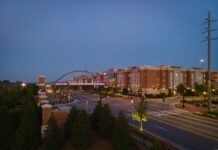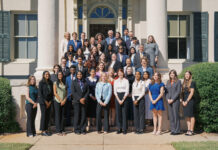They set out for Peru with plans to earn a few course credits while immersed in a new culture. They returned 18 days later as changed young adults with broadened views of life far beyond Mercer University.
Accompanied by nine faculty members, 52 students spent nearly three weeks in the South American country for a Mercer On Mission (MOM) service-learning experience. It was among more than a dozen trips abroad that Mercer On Mission organized this summer.
After a week’s worth of classes on the Mercer campus, students and faculty in the Peru group traveled to the country’s Laberinto district. This community revolves around gold mining, and the Mercer participants took a holistic approach to addressing the residents’ needs.

Dr. Adam Kiefer, Distinguished University Professor of Chemistry, who led the Mercer group, said chemistry students analyzed mercury air pollution from artisanal and small-scale gold mining, and engineering students worked on a mercury air-capture system. An education team helped local teachers improve their lesson plans; a public health team addressed health concerns across the community; and an emergency medicine team gauged the town’s emergency preparedness and provided first aid and CPR training.
A dozen Mercer On Mission participants served as Spanish translators for the group, and journalism students documented the work. These students were essential to the trip’s success, since they helped break cultural barriers, connect with the community and gain the residents’ trust.
“Our goal is to bring as many different perspectives to the same trip,” Dr. Kiefer said. “The students drive this program. They drive the service. They drive the fundamental research. I don’t think there is anywhere else in the world that you have these components coming together to develop a program like Mercer On Mission.”
The University did similar work in Ecuador for about five years. When Ecuador banned the use of mercury in small-scale gold mining, the work and mission were transitioned to Peru for the 2018 trip.
One of the translators was rising sophomore Sebastian Tomala, who is on the pre-med track and is a double-major in chemistry and Spanish. He is a native Spanish speaker whose parents are from Colombia and Ecuador.
He said translating was a tough job, but he was happy to be able to help and put his skills to use. He has been to Latin America previously, but this was the first time that he saw the struggles of the Laberinto village.
“It’s always a culture shock, and that really is the point,” Dr. Kiefer said.
“The real goal of Mercer On Mission is to see our students change, to have their worldview widened and to have total exposure. Our students got that far and away on this trip.”
Tomala said it’s very likely that he’ll go on the Peru trip again next summer. Some of the most memorable moments for him were touring a local hospital, meeting the head of a military post, and spending a weekend in the Amazon rainforest in an ecolodge. He’ll never forget how the children asked for the Mercer team members’ autographs as a way to remember them.
“It was just a great experience overall. We met some great people over there. … They’re really good people. They need help, and we can provide it,” Tomala said. “I thought the trip was out-of-this-world amazing. It was an eye-opening experience for a lot of people.”
Mercer On Mission is a once-in-a-lifetime chance to practice science out in the field, Dr. Kiefer said. The University uses its state-of-the-art Godsey Science Center to provide a foundation for students to go out into the world and be a part of real change.
Dr. Kiefer said this trip to Peru was a needs assessment that was very successful. The participants determined where mercury pollution is coming from, made great connections and progress working with local teachers, and established an understanding of the public health situation in Laberinto.
“You’re never going to meet all of your goals, and that’s why we keep coming back. That’s one of the hallmarks of the Mercer On Mission program. We are never one-and-done,” he said.
Currently, the University’s chemistry department and medical school are analyzing data collected during the trip to find the best ways to help the Laberinto community in the future and looking at new pollutants and methods of removing mercury. Next year’s goal is to focus the project and further address the community’s needs.











